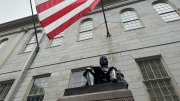Federal Funding and Biomedical Research at Risk
The Trump administration’s February 7 decision to limit federal support for the indirect costs of research funded by the National Institutes of Health (NIH) to 15 percent of direct costs threatens to upend the public-academic research partnership, slow medical discovery—and severely impair the finances of Harvard and peer universities and their surrounding communities. The magnitude of the threat prompted President Alan M. Garber to issue an unusual Superbowl Sunday afternoon email to the community, observing:
The strong, uninterrupted partnership among the federal government, research universities, and industry underpins America’s leadership in biomedical discovery and its application to human health. Federal funding for scientific research has helped make the United States a magnet for outstanding talent, a springboard for ambitious ideas, and a wellspring of rapid and accelerating progress, manifested in an ever-growing list of life-saving treatments for heart disease, cancer, and genetic diseases, along with technological innovations that have strengthened our economy. It is no wonder that the American model—refined and improved over nearly eighty years—is the envy of the world.
On Friday evening, the National Institutes of Health (NIH) released new policy guidance that will weaken that position by deeply cutting an important but frequently misunderstood source of research funding in existing and emerging areas of promise. These circumstances are deeply concerning to many of us.
The bureaucratically titled memorandum, “Supplemental Guidance to the 2024 NIA Grants Policy Statement: Indirect Cost Rates,” notice number NOT-OD-25-068, imposes “NIH’s updated policy deviating from the negotiated indirect cost rate for new grant awards and existing grant awards, effective as of the date of this Guidance’s issuance. Pursuant to this Supplemental Guidance, there will be a standard indirect rate of 15% across all NIH grants for indirect costs in lieu of a separately negotiated rate for indirect costs in every grant” (emphasis added).
In the fiscal year ending June 30, 2024, Harvard received $686.5 million in federally sponsored research grants, consisting of $496.1 million in direct funds (for the scientists’ laboratory expenses, including their research staff members, postdoctoral fellows, and materials) and $190.4 million in support of indirect costs (the specialized facilities in which the research is conducted, utilities, personnel and administrative expenses associated with grant administration, and so on): an apparent indirect or overhead rate of 38.4 percent.
But that understates the risk to Harvard from the new NIH directive. The University’s current facilities and overhead rate agreements, negotiated last July, call for indirect reimbursement rates scaling from:
69.5 percent for on-campus research down to 26 percent for off-campus research for the Medical School (HMS);
54.7 percent down to 26 percent, respectively, for the School of Public Health (SPH); and
69 percent down to 26 percent (but 89 percent for the Wyss Institute) for the rest of the University.
The NIH is by far the largest source of sponsored support for research, and some Harvard units are acutely dependent on it (and other federal and private research sponsors, like foundations) for their basic operations. In fiscal 2024, 35 percent of HMS’s operating revenues of about $900 million came from sponsored research, and 59 percent of SPH’s.
Not all of those schools’ sponsored-research funds come from the NIH, and not all of their NIH funding comes with the maximum negotiated indirect-cost funding. But a reduction in the blended indirect-cost rate from the current 38 percent-plus to 15 percent (a crude estimate, not an accurate calculation) would represent a reduction of more than $100 million in annual support for current and new research work—more than two-and-one-half times the University’s consolidated operating surplus in fiscal 2024. A realistic estimate is that tens of millions of dollars are at immediate risk.
The impacts extend far beyond universities’ financial statements:
•Academic research has been fundamental to biomedical discoveries, ranging from the basis for mRNA-based COVID-19 vaccines to the glucagon-like peptide-1 (GLP-1), the molecule on which current obesity and diabetes therapies like Wegovy are based. (Professor of medicine Joel F. Habener was named co-winner of the 2024 Lasker Award for his work on the latter.)
•Such discoveries have proven both therapeutically and economically significant. For example, Eli Lilly and Novo Nordisk have recently announced $16 billion in U.S. manufacturing investments just for their GLP-1 therapies.
•Academic medical centers are at risk, too. Harvard’s affiliated hospitals, whose results are independent, collectively receive far more funding from the NIH than does the entire University. In fiscal 2024, Mass General Brigham was awarded more than $1 billion in NIH funding, Boston Children’s Hospital $230 million, Dana Farber Cancer Institute $164 million, and Beth Israel Deaconess Medical Center $120 million. Their research, clinical care, and medical training functions overlap, and will likely all be affected by the change in NIH’s reimbursement formula.
•And finally, the Boston-area life-sciences ecosystem (at the top of President Garber’s academic agenda), like those in California and elsewhere, will be affected. After years of torrid venture-capital investment in biomedical startups and expansions by pharmaceutical companies yielded a near-zero lab vacancy rate, the Boston Globe has reported that such vacancies now exceed 21 percent of area facilities (nearing the rate of office vacancies)—representing some 11 million square feet of laboratories on the market or nearing completion.
Harvard and Tishman Speyer, developer of the private enterprise research campus (ERC) in Allston, on leased University land, have not disclosed the tenant for the life-sciences/lab facilities rising there, so it is unknown whether that space is leased or subject to current market risk. But a major change in the market for biomedical and life sciences facilities could influence the pending second phase of that project, which is predicated on large new life sciences and laboratory facilities. A slowing in biomedical and pharmaceutical research and investment could affect the timing and/or economics of that phase of the ERC—and Harvard’s hope to begin earning a return on its enormous investments in land and infrastructure there.
In the view of some university critics, the indirect-cost monies subsidize other parts of academic operations, such as the arts and humanities, which don’t receive equivalent federal research funding. To the extent that critics dislike the politics or ideologies they attribute to those fields, reducing indirect-cost recoveries is a way of reining in undesirable activities.
That may, in fact, have the economics exactly backward. It is true that Harvard and its closest peers have negotiated high indirect-cost recovery rates—reflecting the costs of specialized facilities for especially demanding research, and the prevailing level of expenses in their urban communities. But HMS, for example, is actually operating at a loss, according to its fiscal 2024 financial disclosure, once one-time funds are removed from its accounts: $27 million of red ink on revenues of $898 million (based on Generally Accepted Accounting Principles). Given the costs of wet-lab research, HMS has operated in the red more often than in the black in recent decades, despite property sales, restricting of debt, and other efforts.
Friday’s announcement, which would reduce NIH spending on indirect costs by some $4 billion annually, if effected, also points to a diminution of biomedical research across the United States. Given historical support for such research funding in Congress, and the existing contractual arrangements for such reimbursement between academic institutions and the government, legal challenges to Friday’s announcement may well be forthcoming.
In the meantime, vice provost for research John H. Shaw advised the community on February 9 that the proposed changes in indirect cost reimbursement “would mean a substantial reduction in the resources available to support research at the University and other public and private institutions across the country,” especially schools engaged in the life sciences.
At Risk: 7 Ware Street
During fiscal year 2024, distributions from the endowment totaled $2.4 billion of Harvard’s $6.5 billion in operating revenue (37 percent), and federal support for research accounted for a further 11 percent. These pillars of a seemingly well-diversified set of income streams formed the basis for an eleventh consecutive year of operating surpluses. What’s not to like?
Alas, plenty. Under the political circumstances prevailing in Washington, D.C., universities like this one could find their financial foundations shaken—and at worst, shattered. After years of rising public dissatisfaction with higher education—driven by escalating term bills, student debt, uncertain connections between degrees earned and jobs attained, and (especially of late) partisan anger over ideological concerns about diversity/faculty liberalism/alleged student indoctrination/all-around wokeness (further inflamed by the wide perceptions of antisemitism on many campuses)—the sector is in bad odor. And Republican critics now control the White House and Congress. Their decisions may impinge not only on universities’ ledgers but on their capacity to fund the financial aid and research fundamental to learning and discovery.
What is educators’ doomsday scenario?
Begin with the endowment, by far Harvard’s largest source of revenue. During the campaign, President Donald J. Trump (University of Pennsylvania Wharton School)—he of the fraudulent “Trump University”—broached the idea of taxing endowments heavily to pay for a national, free, online “American Academy” sanitized of “wokeness or jihadism.”
Turning to gritty tax code realities, the endowment earnings of a few dozen of the richest institutions have been subjected to a 1.4 percent excise levy since Congress enacted the first Trump administration’s Tax Cuts and Jobs Act (2017). The mechanics are complicated, but (to the extent one can suss information out of Harvard’s disclosures) the burden at the current rate is not onerous—yet.
According to the University’s 2022 tax return (for the fiscal year ending June 30, 2023), the latest available, the total provision for taxes and fees was $52 million. That figure lumps together actual tax payments for investment income received and realized investment gains; a provision for taxes on unrealized gains; other levies on unrelated business income; and perhaps other items. That makes it difficult to draw a line from total endowment investment returns (income, realized and unrealized gains) of $1.3 billion for that fiscal year to the tax return data. The financial supplements to the Faculty of Arts and Sciences’ fiscal 2023 and 2024 financial reports (presented on a different basis from the University accounts) show tax provisions of $13.3 million and $7.8 million, respectively; FAS’s endowment distribution each year was roughly $1 billion.
Despite these seemingly manageable stakes, the affected universities lobbied vigorously against imposition of the tax because it set a precedent. Smart cookies. During his brief tenure as a U.S. Senator, JD Vance (Yale Law), now vice president—a fiery critic of higher education—introduced S. 3514, aiming to increase the tax rate to 35 percent. Assuming (unrealistically) that the effect, if enacted, were simply to scale up the tax bills arithmetically 25-fold, the fiscal 2024 take from FAS would have been nearly $200 million: roughly equal to its entire unrestricted reserves, or to the quarter-billion dollars or so it spent on undergraduate financial aid that year. Extended across the University, and applied to the nearly $4.5 billion in endowment returns during the year (income plus realized and unrealized gains), the annual bill, to be paid over time, could extend from nine figures to 10.
How about the research enterprise? Federal support for research totaled $686 million in fiscal 2024. As Harvard’s annual financial report observes, the chief source of those funds is the Department of Health and Human Services (HHS)—principally the National Institutes of Health (NIH). The Medical School derived 35 percent of its revenue from sponsored support (federal and other sources) that year, and the School of Public Health 59 percent.
Whether or not Robert F. Kennedy Jr. ’76 is confirmed as HHS secretary, both schools need to be wary about the popularity of his skepticism of much biomedical research. And although President Alan M. Garber spoke favorably of his former student and research collaborator Jayanta Bhattacharya in a Crimson interview, a Wall Street Journal report noted that the nominee for NIH director was interested in tying research funding to schools’ ranking in the Foundation for Individual Rights and Expression (FIRE) survey of free speech. Given the flaws in that survey, on which universities like this one, with law and public policy schools and lots of visiting speakers, inherently score poorly (see professor of government Ryan Enos’s devastating critique of the methodology and results in the Chronicle of Higher Education last February), this would be a discouraging metric for a science-based agency. Either way, a lot of biomedical research funding—presumably among Harvard’s least political, most useful, applied work—is at risk.
Nor could private support (about $235 million in fiscal 2024) close any gap. A significant slug of federal funding ($190 million of the $686 million) covers “indirect” costs, like the buildings where researchers’ labs are based. As a general matter, corporate, foundation, and individual research grants (“non-federal sponsors”) will pay only a far smaller fraction of such overhead.
Level-headed analysis, in short supply these days, suggests the rhetorical rumblings of political retribution won’t magically translate into policy, suddenly depriving Harvard of, say, a billion dollars in annual revenue. (If that did happen, the University would no doubt prioritize financial aid; appeal urgently to every possible donor for help; possibly tap the endowment on an emergency basis; rejigger its investments over time to minimize taxable gains to the extent practicable; and tighten its belt—frantically and hard. Crimson financial administrators and public-affairs advocates in Washington are assuredly working on just such contingencies.)
Beyond ideological war cries, though, national fiscal straits pose a more daunting, continuing challenge. Enormous federal deficits, accumulating debt, and rising interest costs seem unlikely to derail the new White House and congressional drive to extend, and perhaps supplement, the 2017 tax cuts. There will be ideas aplenty for offsetting some of the costs: imposing tariffs (a Trump favorite), repealing clean-energy programs, further immiserating recipients of food assistance and Medicaid, defunding the Internal Revenue Service, and so on.
In the resulting legislative scrum, it is easy to imagine higher-education critics aiming for a twofer and going where the money is: rich universities’ endowments look most appealing, perhaps along with less generous federal funding of financial aid and other programs. In general, one might expect ever more emphasis on today (gunning the economy, slashing taxes), and ever less on tomorrow (investing in knowledge and infrastructure, paying for an energy transition). That bodes ill for the kinds of public support higher education has long enjoyed: directly, through appropriations for research and financial aid; and indirectly, through the tax-exempt treatment of philanthropy and endowment earnings. (In the misery-loves-company department: peers and fellow research powerhouses like Yale, excluding its hospital revenues, and Princeton are much more endowment-dependent than Harvard.) And if the financial markets’ recent returns revert to longer-term (lower) norms, as often occurs after periods of ebullience, so much the worse.
Seemingly robust institutions already show strains. Harvard Medical School broke even on an unrestricted cash basis in fiscal 2024 only because it “deployed flexible cash reserves”; applying Generally Accepted Accounting Principles, it reported a $27-million deficit. Atop continuing investments in people, plant, and equipment, the school probably needs to raise very large sums to restore its competitive position versus peers offering many students tuition-free aid packages. And despite raising $4.4 billion during its current capital campaign, Brown University recently reported that it expects a $46-million “structural deficit” this fiscal year, rising to $60 million of red ink in fiscal 2026. It is imposing an austerity plan meant to balance the budget “over the next five or six years.”
Given the national political and fiscal contexts, it wouldn’t take much—through animus or by accident—to demolish universities’ business models, carefully diversified during the past half-century. The resulting costs in forgone student aid and research could rapidly mount much higher.
—John S. Rosenberg









